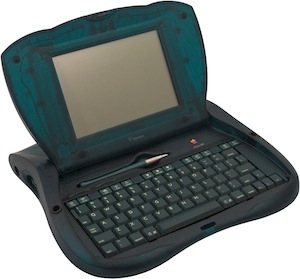iPad in Education
About ten years ago I spent the majority of my time travelling between libraries in the UK and Ireland, researching for my PhD. This was a notes gathering exercise for about two years, as I collected material relating to my research field in Liverpool, Nottingham, Manchester, London and Dublin.
In those days I had two main tools to hand- my Apple PowerBook G3 laptop, and my trusty Apple eMate. Many people may have forgotten or may not even be aware of the eMate 300. It was launched in 1997, and was a small, light, green plastic mini device, a cross between a PDA and a laptop- a netbook without the net!

This light PDA/laptop hybrid meant it was easy to carry around libraries, and was ideal for notes. The keys were smaller than on a standard PowerBook keyboard, but it was still comfortable to work on. It also had a stylus pen, which worked on the touch screen. There was no mouse input, and so you controlled windows and dialogue boxes using the pen on the greyscale screen.
All of this came to mind on the launch of the new iPad. The ability to carry a light tool for research is close to my heart, and the iPad follows in this path. The eMate allowed me to move around a library, with it in hand, and without being weighed down. There was always a concern that if I brought my PowerBook G3 to a library, what did I do whenI needed to walk over to shelves to look for a book. Did I bring the PowerBook with me each time? With the eMate, it was light and had a handle, so it was easy to carry with me on each trip, to ensure it wasn't stolen during my searches.
The iPad fills this sector perfectly. It can be carried around libraries, to lectures, and can be typed on silently (something the eMate did not do). Furthermore it keeps you connected to the outside world (via WiFi and/or 3G) and makes transferring your files back to a Mac or PC very easy, using the USB connection or through email. In fact it appears to match the needs in education so perfectly, as most student and researchers need word processing, note-taking, internet, email and all in a unit which is small and light.
I see the iPad as being huge for one of Apple's largest markets, the education sector. The biggest buying season for this market is from May to September, and so the launch of the iPad in March readies this device perfectly for the buying season, something which we are sure was towards the front of Apple's thoughts.
We see the iPad as being a success; certainly in education and probably in the wider field.
Simon Spence/2010
In those days I had two main tools to hand- my Apple PowerBook G3 laptop, and my trusty Apple eMate. Many people may have forgotten or may not even be aware of the eMate 300. It was launched in 1997, and was a small, light, green plastic mini device, a cross between a PDA and a laptop- a netbook without the net!

This light PDA/laptop hybrid meant it was easy to carry around libraries, and was ideal for notes. The keys were smaller than on a standard PowerBook keyboard, but it was still comfortable to work on. It also had a stylus pen, which worked on the touch screen. There was no mouse input, and so you controlled windows and dialogue boxes using the pen on the greyscale screen.
All of this came to mind on the launch of the new iPad. The ability to carry a light tool for research is close to my heart, and the iPad follows in this path. The eMate allowed me to move around a library, with it in hand, and without being weighed down. There was always a concern that if I brought my PowerBook G3 to a library, what did I do whenI needed to walk over to shelves to look for a book. Did I bring the PowerBook with me each time? With the eMate, it was light and had a handle, so it was easy to carry with me on each trip, to ensure it wasn't stolen during my searches.
The iPad fills this sector perfectly. It can be carried around libraries, to lectures, and can be typed on silently (something the eMate did not do). Furthermore it keeps you connected to the outside world (via WiFi and/or 3G) and makes transferring your files back to a Mac or PC very easy, using the USB connection or through email. In fact it appears to match the needs in education so perfectly, as most student and researchers need word processing, note-taking, internet, email and all in a unit which is small and light.
I see the iPad as being huge for one of Apple's largest markets, the education sector. The biggest buying season for this market is from May to September, and so the launch of the iPad in March readies this device perfectly for the buying season, something which we are sure was towards the front of Apple's thoughts.
We see the iPad as being a success; certainly in education and probably in the wider field.
Simon Spence/2010
blog comments powered by Disqus
